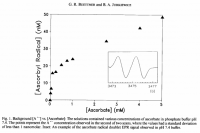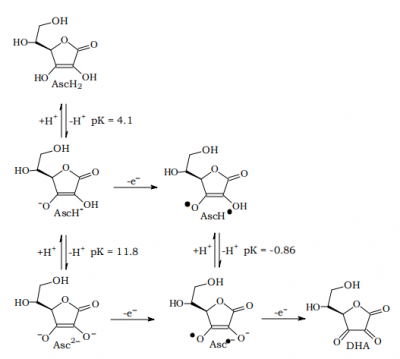Ascorbate Radical
The 1-electron oxidation of ascorbate, the conjugate base of ascorbic acid (aka vitamin C), leads to the ascorbate radical.
The ascorbate radical is one of the most studies radicals. As shown in Figure 1 (see below) of the 1993 paper by Buettner, the ascorbate radical shows a rather simple doublet (inset) indicating the unpaired electron interacts with a single proton. Interpretation of this EPR signal leads to our understanding of how the unpaired electron is localized within the molecular frame. Using the simulated data below, determine the proton hyperfine coupling constant (hfcc)...
| Ascorbate radical |  |
reference | simulated data |
In addition to the hfcc, the above spectrum has been fit using the linewidth fitting parameter. In the above EPR spectrum of the ascorbate radical the linewidth is relatively broad (~0.5 G). Although linewidth is an intrinsic property of the radical species in the given sample environment, a sample of ascorbate radical can be prepared where the linewidth is significantly narrower (<0.1 G). The proton hfcc (aH~1.8 G) is assigned to the proton at carbon-4. There are protons on carbon-5 and carobon-6, but since the unpaired electron density is highly localized on the lactone ring the hfcc for these other protons is significantly less than carbon-5 proton. Using the simulated data below, determine the proton hfcc observed in this EPR spectrum...
| Ascorbate radical - small linewidth |  |
reference | simulated data |
Ascorbic acid chemistry can be summaries by the following graphic that was presented by Buettner.
This extremely simple EPR spectrum has lead to extensive research related to ascorbic acid and it role as an antioxidant.
- -insert WebMO calculations and radical potential map...

